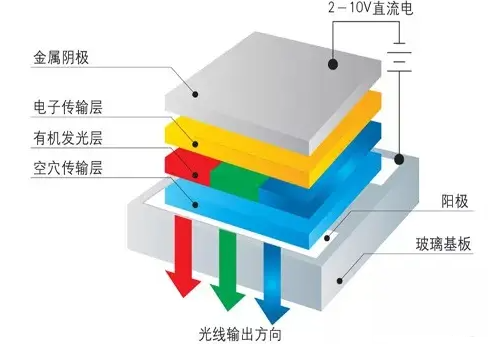Structure varieties of OLED
There are numerous shape styles of OLED, in particular consisting of single-layer shape and double-layer structure.

The unmarried-layer structure OLED is the most primary shape, inclusive of an anode, an emitting layer, and a cathode. The organic layer serves not most effective because the emitting layer but also as the electron shipping layer and the hollow shipping layer. The natural layer may be natural light-emitting small molecules, light-emitting polymers, or doped mild-emitting small molecules. This shape is generally utilized in polymer organic light-emitting gadgets, characterised by its simplicity and occasional manufacturing cost, but with particularly low brightness.
The double-layer structure OLED includes layers of natural substances with exceptional capabilities. One type makes use of organic electron shipping materials as both the electron shipping layer and the emitting layer, forming the OLED collectively with the hollow delivery layer composed of organic hollow shipping substances. the opposite type stocks an natural layer fabric between the hollow transport layer and the emitting layer, with a separate natural layer material because the electron shipping layer. This shape will increase brightness with the aid of including an additional emitting layer however additionally increases production charges and complexity.
furthermore, there may be also the multi-layer shape OLED, which stacks multiple emitting layers together to obtain excessive brightness, excessive evaluation, and high coloration performance. however, this also results in increased production expenses and technical challenges.
The primary structure of OLED includes depositing a layer of natural emitting fabric, tens of nanometers thick, on indium tin oxide (ITO) glass to shape the emitting layer, with a low paintings characteristic metallic electrode above the emitting layer, forming a sandwich-like shape.
Substrate (transparent plastic, glass, metal foil) — the base layer helps the complete OLED.
Anode (obvious) — The anode gets rid of electrons (developing electron “holes”) while modern-day flows through the device.
hole shipping layer — this layer consists of natural cloth molecules that transport “holes” coming from the anode.
Emitting layer — this accretion includes natural cloth molecules (one of a kind from the conductive layer), in which the emission manner takes place.
Electron delivery layer — this residue includes organic material molecules that delivery electrons coming from the cathode.
Cathode (can be obvious or opaque, depending on the kind of OLED) — whilst there may be modern flowing through the device, the cathode injects electrons into the circuit.
OLED is a double injection-type light-emitting tool. under outside voltage riding, electrons and holes injected via the electrodes shape electron-hollow pairs (excitons) trapped within the exciton level inside the emitting layer. Excitons radiatively decay to emit photons, producing seen mild.
To enhance the injection and delivery capabilities of electrons and holes, usually, a hollow transport layer is added among ITO and the emitting layer, and an electron shipping layer is added between the emitting layer and the metal electrode, accordingly improving the mild-emitting overall performance. in this manner, holes are injected by means of the anode, at the same time as electrons are injected by the cathode. Holes leap shipping on the best occupied molecular orbital (HOMO) of the organic material, and electrons leap delivery on the bottom unoccupied molecular orbital (LUMO) of the organic cloth.
carrier injection: beneath the movement of an external electric powered field, electrons and holes are injected from the cathode and anode, respectively, into the natural useful layer sandwiched among the electrodes.
carrier transport: The injected electrons and holes migrate from the electron delivery layer and hole delivery layer, respectively, to the emitting layer.
carrier recombination: After being injected into the emitting layer, electrons and holes form electron-hole pairs (excitons) because of the Coulomb force.
Exciton migration: due to the imbalance of electron and hollow delivery, the number one formation area of excitons commonly does now not cover the complete emitting layer, resulting in diffusion migration because of attention gradients.
Exciton radiative decay: Excitons go through radiative transitions, emitting photons and liberating electricity.
The coloration of OLED emission depends on the kinds of organic molecules inside the emitting layer. placing several natural thin films on the equal OLED constitutes a coloration show. The brightness or depth of mild relies upon on the performance of the light-emitting material and the significance of the implemented modern-day. For the equal OLED, the higher the current, the higher the brightness.
In phrases of show overall performance, OLED screens have the subsequent benefits over lcd:
coloration illustration: OLED displays use the precept of spontaneous emission, where every pixel may be independently controlled, ensuing in greater vivid and colourful coloration illustration. liquid crystal display screens can be enormously weaker in colour illustration.
response time: OLED displays have very speedy response times, able to exchange pixel states inside microseconds, resulting in higher smoothness and detail representation while showing dynamic snap shots or videos. liquid crystal display monitors have enormously slower response times, main to ghosting results and impacting visual experience.
Viewing angle effect: OLED displays can reap a bigger viewing perspective effect, with minimum shade and brightness variation when viewed from unique angles, imparting a extra solid visible revel in. liquid crystal display monitors, the use of backlighting standards, have a highly smaller viewing attitude effect, with enormous color and brightness versions.
assessment and brightness: seeing that every pixel emits mild independently, OLED can present true deep blacks on a black historical past while preserving clear, vibrant photographs from diverse angles, providing a advanced visible revel in. moreover, OLED displays commonly have higher brightness.
flexible design: OLED shows use organic substances, making them greater conducive to bending and flexible layout, consequently permitting the development of bendy and curved displays.
however, liquid crystal display additionally has its blessings in certain factors, consisting of probably having a longer lifespan and durability. In specific utility eventualities, inclusive of static picture display, lcd may additionally exhibit higher performance.